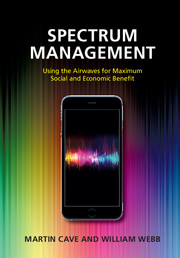Book contents
- Frontmatter
- Contents
- Preface
- Acknowledgments
- Plan of the book
- List of abbreviations
- Part I Fundamentals
- Part II Economic management of spectrum
- Part III Sharing and other emerging approaches to spectrum management
- 8 Spectrum sharing and the commons
- 9 Dynamic spectrum access
- 10 Controlling interference: licensing and receivers
- Part IV Case studies and conclusions
- About the authors
- Index
- References
10 - Controlling interference: licensing and receivers
from Part III - Sharing and other emerging approaches to spectrum management
Published online by Cambridge University Press: 05 November 2015
- Frontmatter
- Contents
- Preface
- Acknowledgments
- Plan of the book
- List of abbreviations
- Part I Fundamentals
- Part II Economic management of spectrum
- Part III Sharing and other emerging approaches to spectrum management
- 8 Spectrum sharing and the commons
- 9 Dynamic spectrum access
- 10 Controlling interference: licensing and receivers
- Part IV Case studies and conclusions
- About the authors
- Index
- References
Summary
Introduction
In previous chapters we have seen how one of the key functions of spectrum management is the control of interference. In Chapter 2 we looked at how interference occurred and towards the end of the chapter noted the difficulties in optimally regulating interference levels.
In this chapter we build upon an understanding of interference to look at how licenses might be structured so that they better define and control interference levels – enabling market mechanisms such as change of use without compromising nearby users of spectrum. This naturally leads on to looking at whether the performance of receivers in an interference environment requires greater specification.
Spectrum usage rights
Introduction
In a world where the use of a band of spectrum is unchanging, the regulator can determine various band parameters such as transmission levels and guard bands based on these specific uses and technologies. This is the approach that has been adopted for over a century. However, with increasing change of use of spectrum, e.g. from broadcasting to mobile broadband, this assumption is no longer valid. When the use of the band changes, the interference levels and patterns can change massively, potentially causing issues to existing users. If these existing users do not have some level of certainty about the interference they may suffer in the future (in some cases 10–20 years hence) then they may not invest in expensive infrastructure. Therefore, some solution to this problem that allows for change of use of spectrum but also provides certainty of interference levels is needed.
The actual interference suffered by a license holder will depend on the power emitted by the neighboring base station and the distance from that base station. A network of a relatively small number of high-power sites, such as that used by broadcast systems, would result in relatively few areas where interference might be experienced, but these areas would be relatively large. Conversely, a network of many medium- or low-powered sites, such as used by a cellular system, would result in many more areas where interference might occur, but these areas would be smaller.
- Type
- Chapter
- Information
- Spectrum ManagementUsing the Airwaves for Maximum Social and Economic Benefit, pp. 192 - 204Publisher: Cambridge University PressPrint publication year: 2015



